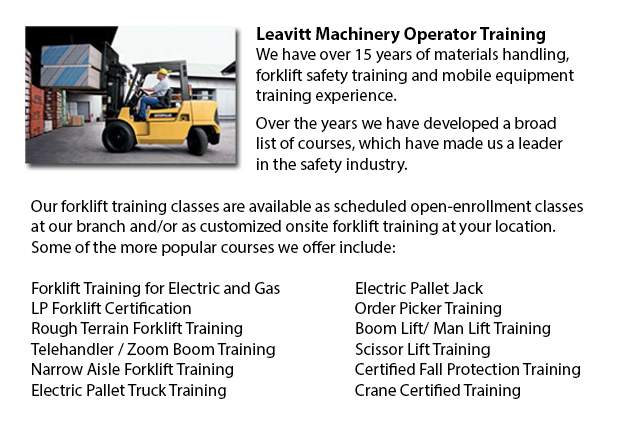
Rough Terrain Forklifts Training Saskatchewan - There are in fact two categories of forklifts within the manufacturing business, the rough terrain model and the industrial version. Rough terrain forklifts appeared in the 1940's built primarily for use on uneven surfaces, best for lumberyards and building sites, providing lifting muscle when there was no paved surface available.
Usually, nearly all rough terrain forklifts are run on a propane, diesel or gasoline powered internal combustion engines with a battery used for power. Several manufacturers are experimenting with rough land lift trucks that consume vegetable matter and run from ethanol. Large pneumatic tires with deep treads typify these forklifts to permit them to latch onto the roughest soil type without any slippage or drifting.
A few of the earliest versions of rough terrain forklifts had the ability to haul in excess of 1000 lbs, by means of blades that could slide underneath the item, lift it marginally and shift it to another location. After more than ten years on the market, rough terrain forklifts were augmented with added carrying power, increasing the possible load to more than 2000 lbs. Telescoping booms were added in the 1960's, allowing them to stack supplies a good deal higher than in earlier years. The telescoping design feature is a staple of most rough terrain lift trucks at the moment. Present styles are capable of managing well over 4000 lbs thanks to the constant enhancements over the years. Telescoping ability has also improved with some versions reaching a height of 35 feet. Worker safety has also become a focus with some all terrain lift trucks currently manufactured are fitted with an enclosed cab for the operator, versus the older open air seating capacity.
The rough terrain forklifts offered these days work just as well on covered floors as on unpaved surfaces. These all terrain forklifts are being marketed for their adaptability permitting companies to transport items from outside the plant to the inside or vice versa.
-
Pneumatic Forklifts
Pneumatic Forklifts Training Saskatchewan - Pneumatic forklifts are known as pallet vehicles or pump trucks and are widely utilized in warehouses and delivery plants to move resources on pallets. Pneumatic jacks comprises a pair of metallic forks mou... More -
Reach Trucks
Reach Truck Training Saskatchewan - Reach Trucks are industrialized equipment utilized for loading and storage in certain firms that maintain storage of materials to finished commodities on a pallet which are then placed into lofty shelving units. Th... More -
Komatsu Forklift
Komatsu Forklift Training Saskatchewan - Komatsu Forklift U.S.A. Inc. has a very good reputation for building reliable and durable lift trucks. Komatsu is acknowledged around the world as a company with a rich heritage while preserving an exceptional... More -
Terex Forklift
Terex Forklift Forklift Training - Terex Forklifts stands by their mission to supply a consistent and cost effective product line. They take pleasure in producing equipment that improves their consumers' earnings. Through many divestures and acquisit... More -
Doosan Forklift
Doosan Forklift Training Saskatchewan - Doosan Infracore Company Ltd. is an international and intercontinental organization which includes Defense Industry Products, Industrial Vehicles, Diesel Engines, Automation Systems, Machine Tools and Construct... More

Forklift Training Saskatchewan
TOLL FREE: 1-888-254-6157
Saskatoon, Saskatchewan
forklifttrainingsaskatchewan.com
Email Us
About Us


